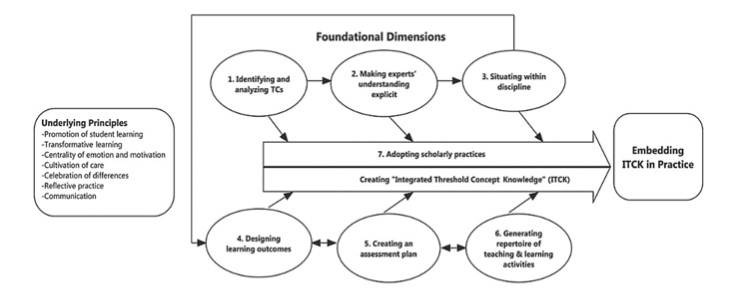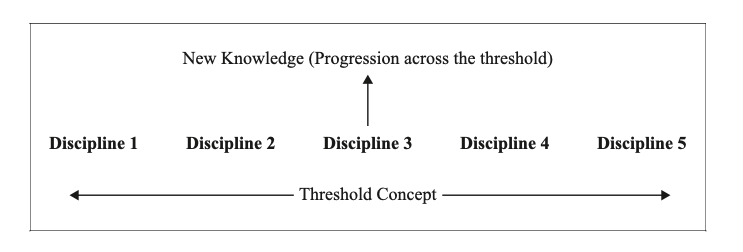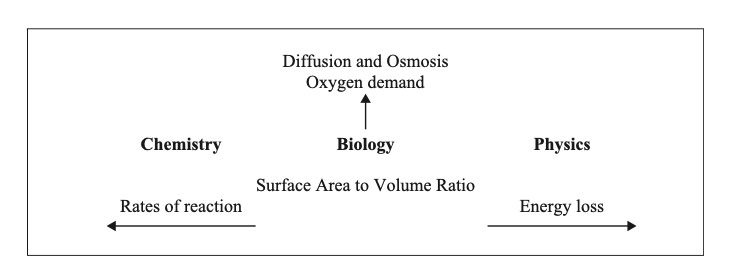Written by | Mark Deacon
Edited by|BISE
Threshold concepts are gateway concepts which once mastered offer routes to understanding other ideas. They are also integrative in that a threshold concept is an idea which pulls other ideas together. This presents the potentially attractive idea that teaching focused on threshold concepts could reduce the time needed to be spend on other areas of the syllabus. Threshold concepts offer a way to streamline what is being taught. They are the means by which crucial points in a student’s learning can be defined and mapped (Cousin 2006).The integrative function of threshold concepts will enable insights which can fill gaps in content learning. Framing how content is selected, presented and assessed (Entwistle 2003; Land et al. 2006). Glynis Cousin (2006) offers an attractive point of view:
focus on threshold concepts enables teachers to make refined decisions about what is fundamental to a grasp of the subject they are teaching. It is a ‘less is more’ approach to curriculum design.
Threshold concepts were proposed by Meyer and Land in 2003 as a means of helping economics tutors in higher education support the learning of their undergraduates. They set up criteria to help identify those areas which are likely to cause students difficulty.
• Transformative: once understood, threshold concept changes the way the student views the discipline.
• Troublesome: the knowledge is counterintuitive, alien or incoherent.
• Irreversible: as they transformative they cannot easily be unlearned.
• Integrative: once learned they draw together different aspect of the discipline.
• Bounded: delimitates a particular conceptual space, serving a limited purpose.
• Discursive: extends the use of language.
• Reconstitutive: over time there will be a change apparent in the learner.
• Liminality: cross the thresh hold is akin to a rite of passage, a liminal space has been transversed.
When dealing with threshold concepts it is important to consider their nature as liminal concepts. Liminality can be regarded as the process of opening a door. Once the doorway is traversed the student can enter a new realm of learning. That is regarded as progression into a new way understanding (Meyer and Land 2003).
Conducting the student’s journey is of great importance, and within the literature there are several examples of practice. Irvine, N. and Carmichael, P. (2009) suggest that there is a process which goes through the stages of:
- mimicry of established scholars
- internalisation
- active shaping of outlook.
There is a body of evidence around discipline-specific shared ways of thinking. As Meyer 2016 observes: disciplines have their own specific content knowledge, ways of thinking about it and behavioural norms. Solomon (2006) stressed that there is a need to engage in argument and interpretation to understand how a discipline develops shared ways of thinking. Solomon cites mathematical proofs as an example where students see a proof as something to be mastered and not as an intrinsic part of thinking like a mathematician.
This is typified by a study of trainee doctors. Trainee doctors were asked a series of questions aimed at identifying when they began to ‘think like a doctor’. This of course illustrates that liminality goes beyond a body of knowledge and ideas and extends to through processes and key behaviours. Interestingly this study was repeated in different countries and a remarkably consistent set of results were produced.
Once the liminal step has been taken, students can then more easily move on to other ideas in the same discipline. Threshold concepts can therefore be considered to be discipline specific. However, it will be differences between individuals as they progress towards mastery. The concepts do provide a foundation for further learning in the discipline. Students demonstrate content knowledge through discursive symbols, such as representative language or behaviour, as well as the ability to correctly decipher disciplinary language (Meyer and Land, 2005).
When the threshold has been passed there is a sense of joining a community of discipline. Meyer and Land (2005) noted:
When employed by experts, discipline-specific language and behaviour represent more than specialized discourse. Such efforts reveal how scholars see themselves, in addition to the manner through which they construct knowledge, view the discipline, shape disciplinary identity, and foster a sense of belonging to the body of scholars in that area
Defining threshold concepts has become a problem, as different disciplines in the higher education sector have used the idea to support their students learning. There are significant numbers of studies where disciplines have used the idea of threshold concepts to identify areas which their students find difficult to master.
Examples of discipline specific knowledge:
• Physics – gravity
• Economics – opportunity cost
• Biology – cells
• Medicine – pain
Examples of discipline-specific behaviours:
• Medical reasoning – thinking like a doctor
• Pharmaceutical practice – managing patients
• Approaches to early years children
The striking feature of the vast amount of subject-specific studies is the eclectic mix of subjects which are being identified as threshold concept. The range of thresholds seem to cover skills, key areas of knowledge, art techniques and interpersonal skills. Of course, all of these are valuable and need to be mastered to gain the desired professional status.
Because of the transferability of the definition of threshold concepts it is argued that it is better to let disciplines decide what is the most appropriate definition of a threshold concept. Meyer notes that across disciplines there is a remarkable similarity between aspects of each discipline that are identified as threshold concepts. Meyer goes on to propose a strategy of allowing teachers to decide what constitutes an area of difficulty for students and are ‘recognised as barriers to learning’. This then raises the question as to whether or not it is helpful to think of these elements of the curriculum not as threshold concepts but as ‘threshold content’.
Some everyday concepts such as ‘burnout’ in the healthcare and other occupational professions are a product of social construction that linguistically embrace a range of commonly experienced or observed human conditions, while others such as the aforementioned ‘limit’ are precise mathematical abstractions. And, in-between there is much room for the positioning of consensus in the first stages of identifying threshold concepts. (Meyer 2016)
There then remains a question as to how we should be defining threshold concepts and how can that process of identification work. Barradell (2013) suggests there are three perspectives which need to be brought to bear:
1. that the identification process needs to have rigour;
2. that transactional curriculum inquiry amongst academics, students and educational developers is important;
3. that this process might be strengthened if it involved participants beyond the educational domain.
Barradell goes on to suggest that consensus between these three strands is going to be important.
The literature contains a range of methodologies used within a range of higher education settings. The first key question is that of sample selection. Barradell (2013) notes that in much of the research sample sections are limited to those in the immediate educational domain rather than the wide communities of practice in the associated professions. Walker (2012) includes an impassioned plea that the learners should be the focus of the enquiry into the nature of threshold concepts. He notes that ‘what we think of them (threshold concepts), might not be what they think of them’.
Much of the research around engaging students in the identification of threshold concepts has involved small populations. Typically, Mangan, J. and Davies, P. writing about economics undergraduates the sample selection was confined to first year students and their lecturers. However, Barradell’s point would suggest that there should be a wider consultation with those who are practising economists bringing in a wider sample with a depth of knowledge born out of practice.
There is a range of methodologies represented in the literature; these include:
• reflective journals,
• questionnaires,
• focus groups,
• measuring student response against expert views,
• iterative analysis or interviews,
• scrutiny of past examination papers.
Timmermann and Meyer (2017) offer a useful framework for thinking through how we might find threshold concepts. Their framework offers clusters of actions which educators can take to help identify threshold concepts.
Cluster 1 is essentially talking to people. For teachers this ought to be stating the obvious. We need to talk to colleagues, experts and, most importantly, our pupils. What is knowledge and first- and second-person experience telling us is getting in the way of progress? This resonates with some of the current work being done in medical schools, where there is remarkable consistency between trainee doctors in medical schools around the world as to what they need to master before being able to think in a clinical way.
What is an expert understanding of a subject area? This is Cluster 2 thinking. How do experts in the subject and teachers (who of course may not be experts) in a specialised area of knowledge conceptualise the area? This process needs to finish with naming the threshold concept in one or two words, an important step as it enables the teacher to crystallise the idea, grasping its essence.
Clusters 3–7 are concerned with designing effective teaching scheme with appropriate learning objectives, activities and assessments which will guide learners through the process of cross the threshold concept.
Timmermann and Meyer’s approach is summarised diagrammatically as

Like the discussion on the use of the term ‘concept’, there would appear to be an emerging pragmatism over the features of threshold concepts. Baradell (2015) notes:
Threshold concepts may never be a ‘one size fits all’; disciplinary differences regarding ways of thinking and practising professionally, academically and pedagogically make sameness impossible and probably unnecessary.
A good test of a putative threshold concept is that it should function horizontally and vertically; i.e. it should allow for progression (liminality) and draw together concepts from other disciplines (integrative) (Barradell 2013).
An example of this is surface-area-to-volume ratio (SA:V), which is extensively represented in current GCSE science syllabuses. It is an idea pupil find difficult to understand, explain and calculate. The reasons for this are:
• difficulty in understanding variables,
• teachers have learned the process by rote and do not necessarily understand it,
• difficulty understanding that the variables function independently of each other, and
• difficulty with the mathematical concept of ratio.

SETTING SA:V AGAINST MEYER AND LANDS CRITERIA
• Transformative: mastery of SA:V will enable pupils to offer explanations of familiar yet complex phenomena.
• Troublesome: when pupils start to calculate SA:V they quickly become confused as small organisms become big organisms this is counterintuitive.
• Irreversible: not immediately clear if this condition applies*
• Integrative: there are many situations in science where the size of an organism or particle affects the way it performs or reacts.
• Bounded: it is a single idea which has many applications
• Discursive: pupils struggle with language in science, and in this content big becomes small, which means they have to use language in a more complex way.
• Reconstitutive: not immediately clear if this condition applies*
• Liminality: This is a concept which recurs at many levels. Pupils need to master it to make progress.

Whilst threshold concepts are making tentative progress into the vocabulary of schoolteachers, it is still largely unfamiliar territory in schools. Discussions in research has largely been centred on undergraduates and those entering specialist postgraduate training。
Schoolteachers will need to be able to locate threshold concepts within the theoretical frameworks they understand. Walker (2013) sought to locate threshold concepts within cognitive theory and draws some very helpful parallels with long-established schema theory.
Schema theory is familiar territory for teachers, having been foundation in teacher training programmes for many years. It was proposed by Bartlett (1932) as a model for how experiences shape behaviours. Scheme can be considered templates against which we measure the world. A scheme is an elaborate thing which is flexible and is essentially reactive, depending on what we are experiencing.
In education and throughout teacher training, schema theory has been taught through the work. This brings teachers into familiar territory. Walker sets out Anderson’s criteria for schema, which immediately draw some obvious parallels with the defined features of threshold concepts:
1. Schema are transformative (they are reorganised when incoming data reveal a need to restructure the concept) and represent a personal ontology (they are organised in a way that is meaningful to the individual).
2. Schema tend to be irreversible (schema are malleable and changeable moment- by-moment as information is received).
3. Schema are integrated (schema are embedded in other schemata, which themselves subsume sub-schema).
4. Schema are bounded (schemas enable gestalt or holistic representations which recognize the boundaries between concepts).
5. Schema can represent ‘troublesome knowledge’ (they often run counter to common sense and have a strong affective component).
This helpful tabulation shows the significant amount of conceptual overlap between schema and threshold concepts. It is important to make the semantic step of recognising that not all threshold concepts are schema and not all schema are threshold concepts.
Using the schema approach, we can start to understand what may be ‘troublesome knowledge’ which becomes liminal and potential causing progression to stop. As pupils progress through the curriculum, they have to remake, create schemas and link schemas. This is a process which pupils find difficult, as it can introduce cognitive dissonance as well as be influenced by the environments.
This brings teachers straight into familiar territory. Best practice suggests that teachers need to approach troublesome knowledge through general knowledge and generic concepts (prior learning). The next step is to help students to restructure their learning in ways that integrate it.
Cousin (2006)34 suggests that curriculum design should be orientated towards understanding and developing practice which will enable pupils to master troublesome knowledge. She offers four principles which could lead to mastery of threshold concepts:
• Explore what appear to be threshold concepts,
• Listen to what pupils are saying, especially the language they are using to shape their knowledge,
• Tolerate confusion and take pupils through what is confusing them,
• Revisit learning.
Exploration of apparent threshold concepts
As set out above the process of identification of threshold concepts involves a dialogue of experts in the field. This is sharing of knowledge and experience which reaches a consensus as to what students find difficult. Other strategies employed in higher education include work and examination scrutiny. This can provide invaluable information about areas pupils are finding difficult to access and explain. One of the areas already explored is the engagement of practitioners outside the immediate context of the institution. Engaging with the wider community of practice must surely be a good thing for science teachers.
Listen to pupils
The power of student voice is already recognised. Within the research literature there is a considerable body of evidence for the effectiveness of this. Cousin does remind us to be careful listeners to the language pupils are using.
Tolerate confusion
There needs to be space created for pupils to articulate their confusion with supportive teachers; this of course touches on areas of classroom management and planning which probably do not arise in HEIs: behaviour management, extension and support tasks, etc.
Revisit learning
With the growth of understanding of memory and practice development through cognitive neuroscience, revisiting prior learning is becoming established good practice and is already incorporated into lesson planning.
At the department level identification of threshold concepts could guide the planning of schemes of work. The liminal nature of threshold concepts makes them worthy of sufficient time which if effective can make progression faster. The integrative nature of threshold concepts should have transdisciplinary impacts, particularly in closely related disciplines.
作者 | Mark Deacon
编辑|BISE
阈限概念是一个学科学习的门槛,一旦掌握了阈限概念,就可以融会贯通将其他知识结合在一起。这给出了一个潜在的优势,即以阈值概念为重点的教学可以减少大纲内其他知识教学所需的时间。阈值概念提供了一种简化教学内容的方法,是定义和映射学生学习中的关键点(Counse 2006)。阈值概念的连接性甚至能帮助学生预见和填补学习中的空白。
Glynis Counse(2006)提供了一个有吸引力的观点:关注阈值概念可以使教师对他们所教的学科的基本知识做出精确的决定。这是一种“少即是多”的课程设计方法。
阈值概念是由Meyer和Land在2003年提出的,起初目的是帮助高等教育中的经济学导师帮助本科阶段学生的学习引入的概念。他们设立了一些标准来帮助他们识别那些可能给学生带来困难的领域(阈值概念)。
- 转化性:一旦理解阈值概念,会提高学生对学科的整体理解
- 棘手性:知识内容本身是陌生的或不连贯的
- 稳固性:一旦掌握不容易被遗忘
- 综合性:可以把学科的不同概念连接起来
- 有界性:界定特定的概念空间
- 延展性:该概念语言的使用可以拓展在学科内部
- 重构性:随着时间的推移跨过该概念后知识的积累,学习者会有明显的提升
- 极限性:跨过该概念后可以将知识触类旁通,反之不能掌握该知识会影响对整个学科的理解
在处理阈值概念时,重要的是要考虑到它们的临界性。阈值可以看作是打开一扇门或迈过一道门槛,一旦穿过,学生就可以进入一个新的学习领域,这被认为是一种理解的进步(Meyer&Land, 2003)。
引导学生越过阈值的过程是非常重要的,Irvine,N.&Carmichael,P.(2009)认为,这一过程经历了以下几个阶段:
1. 模仿已有掌握者
2. 知识内化
3. 建立自己的理解
大量的证据表明特定学科内部有共通的思维方式。正如Meyer 2016所观察到的:学科有自己特定的知识内容、思考方式和行为惯性。Solomon(2006)强调,学科学习不仅仅停留在知识表面,更有必要探索学科内共同的思维方式,以数学为例,学生通常会把数学的证明看作是需要掌握的知识,而数学家则把证明作为思考过程中固有的一部分。
通过对多名实习医生的研究,我们发现了这个现象的明显特征(Randall, Brooks, Montgomery, McNally, 2018)。实习医生会被问到一系列问题来确定何时他们能“以一个医生的角度来思考”,并结束实习。这个研究表明越过阈值不仅仅在知识储备上,而是要延伸到实践的过程和关键行为/意识的产生。有趣的是,这一研究在不同国家反复进行,但结果却出奇的统一。
一旦越过阈值门槛,学生们就可以更容易掌握该学科的其他知识,因此阈值概念可以被认为是因学科而异的。这些概念为学科的进一步学习提供了基础,学生通过这些概念知识进行扩展,展示对学科知识的理解以及正确解读学科语言的能力(Meyer and Land,2005)。
当越过阈值,就会有一种对其他概念都似曾相识的感觉。Meyer and Land(2005)指出:
“特定学科的语言和行为所代表的不仅仅是他们本身,也展示了学科建立者们如何看待自己,他们建构的知识、整个学科、和培养对该领域内学者群体的归属感。”
有大量研究表明,在高等教育中,各学科都在使用阈值概念的概念来帮助学生学习,那么如何识别和定义阈值概念就成为了一个重要问题。
举一些学科特定知识的示例:
- 物理学——重力
- 经济学——机会成本
- 生物学——细胞
- 医学——疼痛
特定学科行为:
- 医学——像医生一样思考
- 制药——患者管理
- 早幼教育方法等
阈值概念通常都是学科中有独有的成功,范围涵盖:能力,关键领域的知识、技术,人际交往技能等。当然,这些都是有一定价值的,需要积累才能获得的专业素养。
由于阈值概念在不同学科中的多样性和可转移性,不能用统一方法定义阈值概念,最好的办法就是由每个学科来决定什么是该领域内阈值概念的最合适定义。Meyer指出,不同的学科的阈值概念有相似性。Meyer还提出了一个方法,允许教师决定什么是学生的困难领域,什么是“公认的学习障碍”。这就提出了一个想法,即不把这些课程要素视为阈值概念,而是“阈值内容”。
“一些日常概念,如医疗中的“过劳”,是社会结构的产物,由大量经验或长期观察到的人类状况产生,而其他概念,如前文提到的“入门概念”,则较为抽象。在这普遍和抽象中间,还有很大的空间可以用来定义阈值概念。” (Meyer,2016)
接下来的问题就是如何定义阈值概念,以及这个识别过程如何运作。Barradell (2013)建议以下三点被需要考虑:
1.识别过程需要严格
2.学者、学生和教师和教研开发者之间的联系很重要
3.如果这个过程涉及教育领域以外的参与者,会帮助这个过程的进行
Barradell继续指出,这三股力量之间的统一非常重要,其文献包含一系列在高等教育环境中识别确认阈值概念时使用的方法。第一个关键问题是样本选择问题。barradel (2013)指出,在许多研究中,样本取样仅限于直接教育领域,而没有考虑相关专业的广泛实践者。Walker(2012) 指出学习者应该是阈值概念的性质的调查的重点。他表示“我们对阈值概念,可能与他们(学习者)的看法不同”。
许多关于让学生参与阈值概念识别的研究都涉及到小型群体。一个典型的例子是Mangan, J. 和Davies, P. 研究经济学本科生时样本选择限制在大一学生和他们的讲师。然而Barradell的观点表明,应该与那些正在从事经济学相关工作的人进行更广泛的讨论,引入更广泛的样本,汲取实践中证实的知识。 文献中介绍了一系列方法,包括:
- 反思日记
- 问卷调查
- 重点小群体
- 对照专家意见测试学生的反应
- 反复分析或访谈
- 重温过去的评测
Timmermann和Meyer (2017)提供了一个用于找到阈值概念的框架,包含一系列教育工作者可以采取的行动,如下所示:

第1个活动本质上就是和人说话。对于教师来说这应该是最基本的的。我们需要和同事,专家交谈,最重要的是和学生交谈。从各个视角了解是什么阻碍了进步?对一个学科概念,专家是怎么理解的?这是第2项活动。专业领域的专家和教师(他们可能不是专家)如何给该领域下概念?这个过程需要用一两个词来给概念命名,这是一个非常重要的步骤,帮助教师明确意义抓住本质。
第3-7组活动涉及设计有效的教学方案,包括适当的学习目标、活动和评估,以指导学习者通过跨越阈值概念的过程。 在学习过程中,我们通常下意识思考二者相似性,通过已知推断未知,但在识别阈值概念时,这一下意识行为并非有益,Barradell(2015)指出:
“阈值概念可能永远不会是统一的,学科之间专业、学术、教学,思维和实践方式的差异使得统一变得不可能且没必要。 ”
测试一个概念是否是阈值概念的很好方法是,看它是否有横向和纵向运行的特性。也就是说,它应该允许进步(极限性)并能从其他学科(综合性)中吸取概念(Barradell,2013)。

举个例子:比表面积(SA:V),这在目前GCSE科学课程中有广泛使用的概念,同时也是一个学生觉得难以理解、解释和计算的概念。原因如下:
- 有难以理解变量
- 教师也是通过死记硬背来学习的并不一定理解它
- 有难以理解变量间的相互关系
- 对比率的数学概念不理解
把比表面积(SA:V)参照Meyer和Land标准
- 转化性:掌握SA:V将使学生能够对复杂的现象进行解释
- 棘手性:当学生开始计算SA:V时,他们会搞不清真正粒子的大小。(比表面积越大,粒子越小)
- 综合性:在科学学科中广泛应用,如粒子比表面积大小影响其化学反应速率。
- 有界性:这是一个有许多应用的单一概念
- 延展性:学生们需要使用特定的科学语言,因为比表面积数值大指粒子尺寸小,这意味着他们不得不以更复杂的科学语言来描述
- 极限性:这是一个在许多层面反复出现的概念,学生需要掌握它以取得进步
比表面积作为一个阈值概念在科学学科中横纵向特性如下图所示:

虽然阈值概念在中小学中取得了初步进展,但它仍是一个非常陌生的领域。研究中的讨论主要集中在本科及其以上。学校教师需要能够在他们理解的理论框架内找到阈值概念。Walker (2013)试图在认知理论中定位阈值概念并与图式理论平行比较。
图式理论是教师熟悉的领域,是教师培训的基础。它由Bartlett (1932)提出的作为经历如何塑造行为的模型,甚至可以用作衡量世界的模板。图式理论的基模因其灵活性和经历反馈性本质是复杂的。
在教育和教师培训中,都以图式理论为基础,这将教师带回熟悉的领域。Walker提出了Anderson的基模标准,该标准与阈值概念的定义特征有一些明显的相似之处:
- 转化性(可以重构),并代表个人本体(以个人意愿重组)
- 不可逆(性基模是时时刻刻变化的)
- 综合性(模式嵌入在其他模式中,其他模式本身包含子模式)
- 有界限性(基模或整体表征能够识别概念之间的界限)
- 棘手性(通常与常识不符)
这个列表显示了大量图式理论基模和阈值概念之间的重叠。但是不是所有的阈值概念都是基模,也不是所有的基模都是阈值概念。
使用图式基模方法,我们可以开始理解什么可能是“棘手的知识”,也就是导致进展停止的潜在原因。随着学生在课程中的进步,他们必须创建改造和连接多个基模。这是一个学生通常感到困难的过程,因为在该过程中会认知失调,并受到环境影响。 最好的解决方法是教要通过一般知识和一般概念入手,帮助学生以整合的方式重组他们的学习。
Cousin (2006)建议课程设计应该以理解和发展实践为导向,这将帮助学生掌握棘手的知识,为此她提出了以下四个原则:
- 探索阈值概念
- 倾听学生的反馈,尤其是他们使用的语言来描述困难的知识
- 包容错误,并引导学生理解让他们产生的东西,
- 复习
探索阈值概念
上文提到确定阈值概念的过程涉及与该领域专家的对话。这是知识和经验的分享,就学生发现的困难的部分达成共识。在高等教育中会采用的其他策略确定,包括工作和考试审查。这可以提供关于学生关于难以理解知识的信息。
倾听学生的反馈
这项原则是得到认可的,在研究中,有相当多的证据证明了这种方法的有效性。Cousin提醒我们要用心倾听学生描述使用的语言。
包容错误
需要为学生创造空间,让他们向老师表达自己的困惑;涉及到在大学里可能不会出现的课堂管理和规划方法,例如行为管理、课后补课等。
复习
通过认知神经科学对记忆和实践发展的理解的增长的支持,重温是一个必要的行为,并且已经被纳入课程规划中。在学科层面上,确定阈值概念可以指导教学工作计划的规划。阈值概念的初始性质使它值得被分配足够的时间,其综合性应该具有跨学科的影响,特别是在密切相关的学科中。